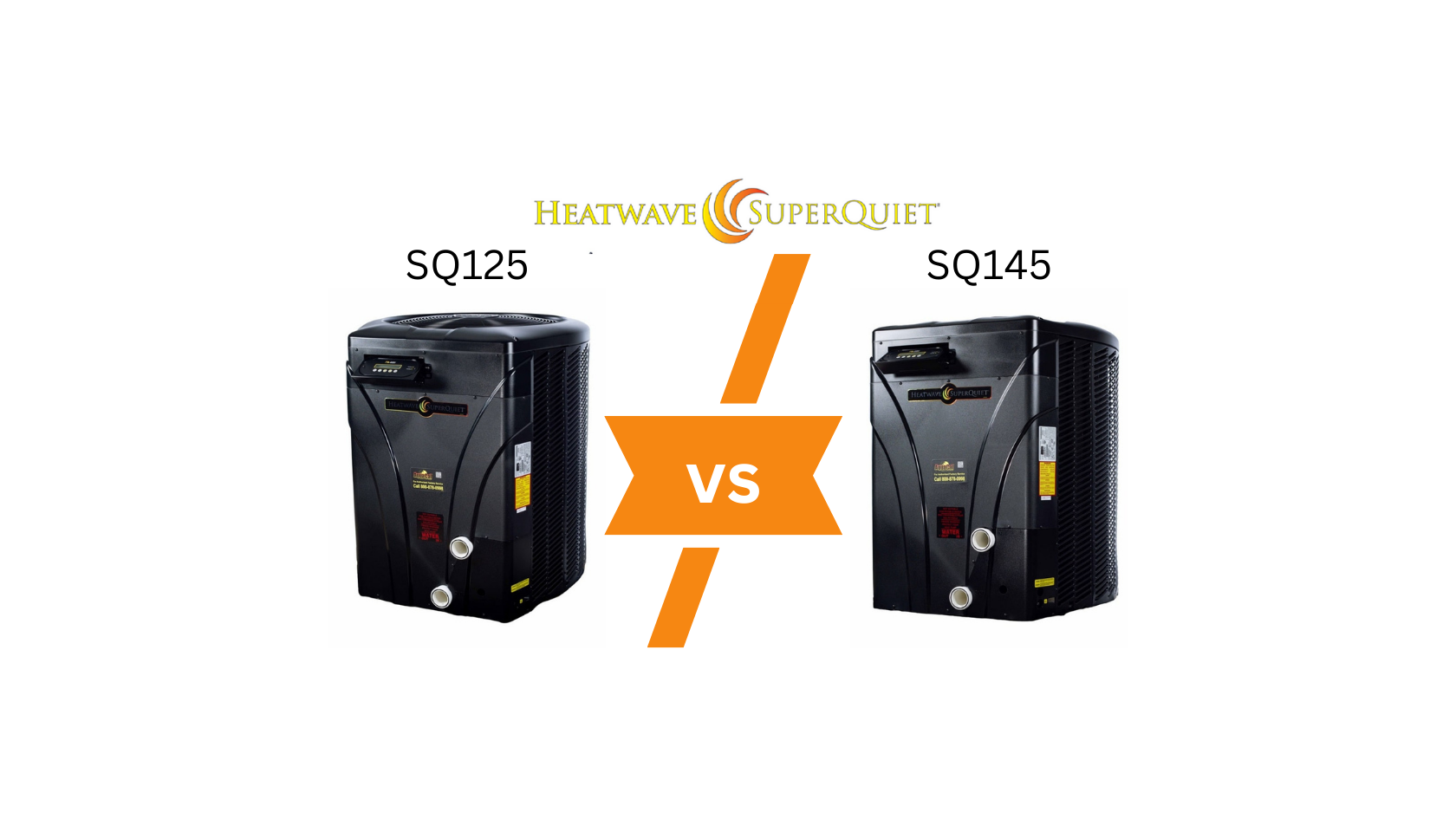
AquaCal SQ125 vs SQ145
Comparing the AquaCal SQ125 and SQ145 pool heat pumps reveals two efficient options with advanced features. Let's explore which one best suits your specific needs.

Crank Up the Heat (and Keep the Noise Down): Comparing the AquaCal SQ125 vs. SQ145
Let's compare these premium heat pumps side-by-side to help you determine which one is the best fit for your pool.
We'll be reviewing the heating capacity, energy efficiency, noise levels, ease of installation, and electrical specifications of the AquaCal SQ125 and SQ145 heat pumps.
AquaCal SQ125 vs. SQ145: Heating Capacity
Winner: SQ145
When it comes to heating power, the SQ145 has a clear edge over the SQ125. The larger SQ145 model generates up to 121,000 BTUs, while the SQ125 tops out at 101,000 BTUs. This extra heating capacity from the SQ145 means you'll be able to heat larger pools more effectively, especially in cooler ambient temperatures.
AquaCal SQ125 vs. SQ145: Energy Efficiency
Winner: SQ145
However, the SQ125 packs a serious punch, with more than enough heating power for the average residential pool. And when you look at the coefficient of performance (COP) ratings, the two models are very closely matched. The SQ145 has a COP of 7.1 at standard testing conditions (80°F water/80°F ambient/80% relative humidity), while the SQ125 has a COP of 6.5. This indicates that both units are exceedingly efficient at transferring heat from the ambient air into your pool water.
In practical terms, the higher COP of the SQ145 translates to slightly lower operating costs. But the difference is relatively modest - you'd likely only see a few dollars per month in energy savings by going with the SQ145 over the SQ125, depending on your local utility rates. So while the SQ145 has a performance edge, the SQ125 is no slouch when it comes to getting the job done efficiently.
AquaCal SQ125 vs. SQ145: Noise Levels
Winner: It's a Tie!
These units are marketed as "SuperQuiet" units, and for good reason! At just 58 dBA for the SQ125 and 59 dBA for the SQ145, these models are remarkably hushed, especially when compared to traditional pool heaters.
To put those noise levels in perspective, normal conversation typically registers around 60 dBA. So the SQ125 and SQ145 are quieter than your average chat with a friend. And they're a far cry from the roar of an old gas heater, which can easily hit 70-80 dBA.
The low noise output of these AquaCal units is achieved through a combination of innovative engineering and premium components. Features like the unique air flow vectoring top and louvered side panels help to minimize turbulence and dampen sound. And the compressors themselves are designed for whisper-quiet operation.
This means you can run your pool heat pump without constantly being reminded it's there. Whether you're relaxing poolside, entertaining guests, or just trying to enjoy the peace and quiet of your backyard, the SQ125 and SQ145 will maintain a pleasantly low profile.
AquaCal SQ125 vs. SQ145: Ease of Installation
Winner: SQ125
Another key advantage of the AquaCal SuperQuiet series is how user-friendly these units are, both during installation and day-to-day operation.
The compact 34" x 34" x 44" footprint of these heat pumps makes them easy to place in tight spaces, like next to your equipment pad or tucked away in a corner. And the built-in condensate drain pan simplifies the setup process by providing an integrated solution for managing water runoff.
While the unit measurements are the same, the AquaCal SQ125 weighs in at 258 lbs, while the SQ145 weighs 305 lbs. This weight difference makes the SQ125 slightly easier to handle during installation.
AquaCal SQ125 vs. SQ145: Electrical Specifications
Winner: SQ145
The electrical requirements are also straightforward, with both the SQ125 and SQ145 available in single-phase 208-230V configurations. This makes them a relatively simple swap-in replacement for many existing pool heaters.
Both the SQ125 and SQ145 come in single-phase 208-230V setups. But the SQ145 also offers three-phase 380-415V and 460V options.
This wider range of voltages for the SQ145 provides more flexibility during the installation process. It makes the SQ145 a better fit for larger homes or properties that have three-phase electrical service already in place.
The Bottom Line...
If maximum heating power, year-round temperature control, and three-phase electrical compatibility are priorities, then the SQ145 is likely the way to go. The extra 20,000 BTUs of capacity make it the more robust and flexible option.
On the other hand, if you have a more modest-sized pool and prefer the simplicity of single-phase power, the SQ125 is an excellent choice that will still deliver exceptional efficiency and comfort. And you'll save a bit on the upfront investment as well.
Whichever model you select, you can rest assured that you're getting a premium pool heat pump from a brand trusted by pool owners for over 40 years. The SQ125 and SQ145 both uphold AquaCal's reputation for quality, innovation, and customer satisfaction.
Get ready to extend your swimming season with confidence!


Leave a comment